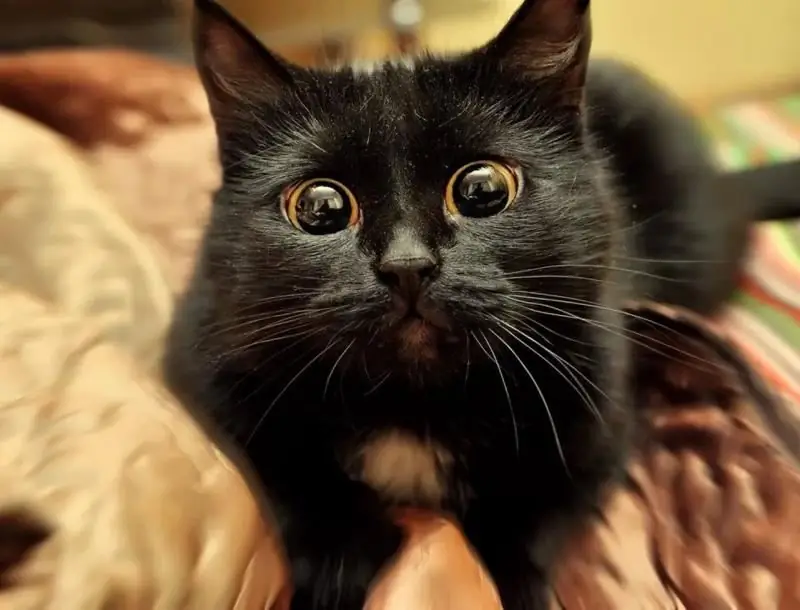
Table of contents:
- Eye diseases in cats: how to keep your pet healthy
- Healthy cat eyes
- Diseases of the eyes in cats
- What symptoms do you need urgent veterinarian help?
- Medicines used for eye conditions in cats
- Folk remedies for treating eyes in cats
- Rules for conducting medical procedures at home
- Caring for cats with eye conditions
- Features of the treatment of eye diseases in pregnant cats and kittens
- Diseases not related to the eyes
- Prevention of eye diseases in cats
- Veterinarian recommendations
- Author Bailey Albertson [email protected].
- Public 2024-01-17 22:26.
- Last modified 2025-01-23 12:41.
Eye diseases in cats: how to keep your pet healthy
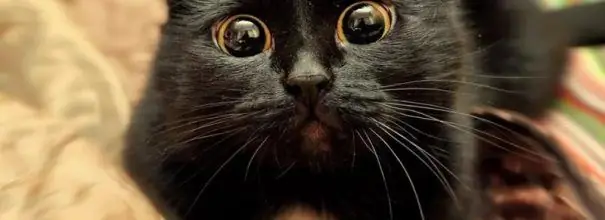
The eyes are the most important organ for a cat, therefore, their condition must be monitored very carefully. In addition, eye problems often signal diseases that affect the entire body. Cat owners need to know what healthy eyes look like and for what symptoms they need to be brought to the vet.
Content
-
1 Healthy Cat Eyes
1.1 Physiological features of the eyes in different breeds of cats
-
2 Eye diseases in cats
-
2.1 Diseases of the eye protection
- 2.1.1 Blepharitis
- 2.1.2 Twisting of the eyelids
- 2.1.3 Ptosis
- 2.1.4 Lagophthalmos
- 2.1.5 Other diseases
-
2.2 Diseases and injuries of the eyeball itself
- 2.2.1 Conjunctivitis
- 2.2.2 Keratitis
- 2.2.3 Glaucoma
- 2.2.4 Other eye diseases
-
- 3 For what symptoms do you need urgent veterinary help?
-
4 Medicines used for eye conditions in cats
-
4.1 Table: drugs used for different types of eye lesions
4.1.1 Photo gallery: medicines for eye diseases
-
-
5 Folk remedies for treating eyes in cats
5.1 Video: Veterinarian shows how to properly treat cats' eyes
- 6 Rules for conducting medical procedures at home
- 7 Caring for cats with eye conditions
- 8 Features of the treatment of eye diseases in pregnant cats and kittens
- 9 Diseases not associated with eyes
- 10 Prevention of eye disease in cats
- 11 Veterinarian recommendations
Healthy cat eyes
In a healthy cat, the eyes should be clear, without clouding, the whites are light, and the eyelids should be free of swelling. Discharge from the corners of the eyes is light, almost invisible.
Health problems are signaled by:
- swelling, redness and inflammation of the eyelids;
- lacrimation;
- discharge from the eyes.
Sick cats squint in the light, sometimes the eye closes the third eyelid.
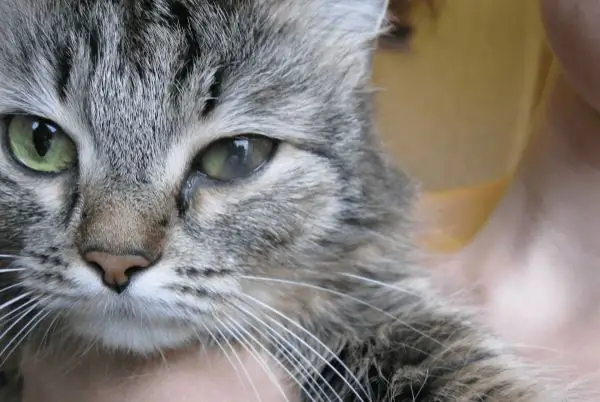
A cat's affected eye is very different from a healthy eye.
Physiological features of eyes in different breeds of cats
In some cases, discharge from the eyes in cats is not a cause for concern. For example, in British and Scottish cats, due to the special shape of the skull, the lacrimal ducts are often narrowed, so these breeds suffer from tearing.
A similar problem occurs in Persian cats, but, in addition to narrowed tear ducts, they also have curved nasal passages, so the discharge from the eyes can be brown. If the cat has received all the vaccinations on time, doctors recommend not to worry about this and daily wipe the cat's eyes with a cotton pad dipped in chamomile infusion or warm boiled water.

Due to the flat shape of the muzzle in Persian cats, the lacrimal ducts and nasal passages are changed
Diseases of the eyes in cats
With all the variety of eye diseases in cats, they can be divided into two large groups:
- Injuries and diseases of protective devices (eyelids and skin around the eyes).
- Diseases of the eye itself, or rather, the eyeball.
Diseases of the eye defenses
Diseases of the eyelids are divided into:
- inflammatory (blepharitis);
- non-inflammatory (volvulus, ptosis, trauma).
Blepharitis
Blepharitis is an inflammation of the eyelids. Often, cat owners confuse it with conjunctivitis, but this is not the same thing at all. There are several types of blepharitis:
- Scaly - got its name from the grayish scales appearing at the roots of the eyelashes. After a while, if untreated, the eyelashes fall out, and pus appears in place of the scales. The eyelids with this disease in cats are red, swollen.
- Ulcerative - develops from scaly. After the pus dries, ulcers remain on the eyelids through which infection can enter the body. When the ulcers heal, the resulting scar tissue often tightens the skin, resulting in a curvature of the eyelid.
- Meibomian - characterized by inflammation and increased secretion of the meibomian glands, which are located at the edges of the eyelids. The disease appears when microorganisms penetrate into the ducts of these glands, as a result of which the latter begin to secrete pus, and the edge of the eyelid thickens and turns red.
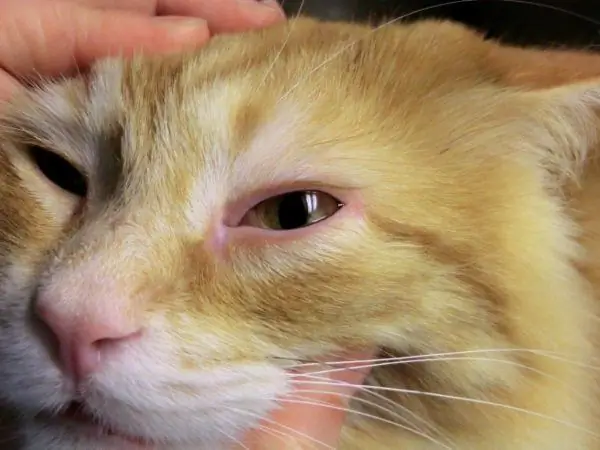
With blepharitis, the eyelids swell, turn red, and crusts and pus may appear on them
Various reasons can lead to blepharitis:
- fungal infections, especially the causative agent of lichen;
- the development of pathological microorganisms, among which streptococci and staphylococci are especially active;
- allergy to food, plants, dust and any other pathogens (in this case, blepharitis is especially difficult, the animal's temperature rises, photophobia begins, it rubs its muzzle against furniture and can damage the eye even more);
- parasitic infestations, especially tick-borne ones;
- mechanical damage, such as scratches in a fight;
- autoimmune and endocrine diseases;
- surgery for transplantation of salivary glands is a rather rare manipulation that surgeons perform in case of insufficient function of the lacrimal glands in cats (malaise in this case is caused by the fact that saliva enzymes aggressively affect the delicate skin of the eyelids).
The veterinarian performs a slit lamp examination, blood test and eyelid biopsy, and then prescribes treatment based on the cause of the disease.
It usually proceeds as follows:
- The edges of the eyelids are disinfected with an antiseptic.
- Gentomycin or methyluracil suspension is injected into the conjunctival sac.
- The crusts and scales are softened with petroleum jelly and carefully removed.
- Drops are instilled into the eye.
- If a fungus is detected, fungicidal ointments and a three-stage vaccination are used.
- If the disease is caused by microorganisms, antibiotics are prescribed to which they are sensitive, in ointments or injections.
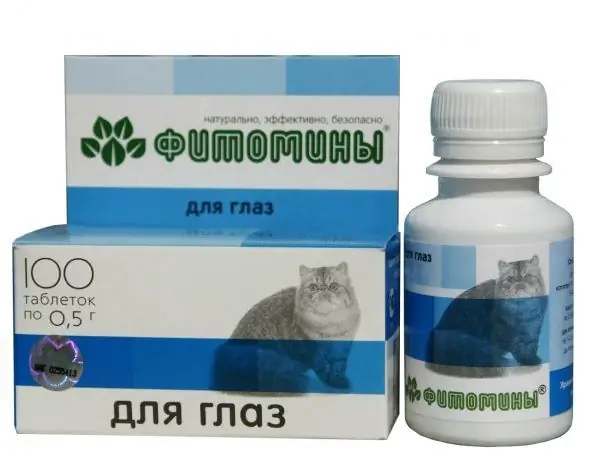
Phytomins are a large series of veterinary products made from natural raw materials and designed to solve various problems that arise in cats and other pets.
Inversion of the eyelids
In this disease, the outer edge of the eyelid turns inward, and the hair and eyelashes covering it injure the cornea of the eye. Most often, Sphynxes, Persians and British suffer from volvulus of the eyelids, but other breeds are not immune from this pathology. There are various reasons for turning the eyelids:
- a congenital defect in the development of the eyelids, in which they grow too long;
- mechanical damage to the eye while playing or fighting with other animals;
- a scar formed after an injury or burn has healed;
- paralysis of the facial nerve;
- age-related changes, loss of skin and muscle elasticity;
- spasm of the muscles surrounding the eyes;
- neoplasms or foreign bodies in the eye.
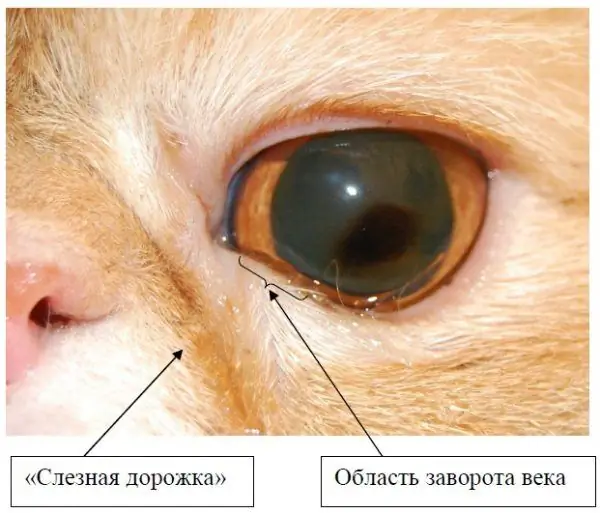
The lower eyelid curls up much more often than the upper
Symptoms of volvulus of the eyelids may be mild at first, but if the disease is not immediately treated, they will increase. The most common signs are:
- redness of the eyes;
- reduction or change in the shape of the palpebral fissure;
- photophobia;
- lacrimation;
- profuse formation of pus in the eyes.
Also, the animal can squint and rub its eyes with its paws. When these signs appear, the cat must be brought to the doctor immediately.
Treatment is as follows:
- The veterinarian takes a blood test, urine test, and electrocardiogram to make sure the cat will undergo anesthesia.
- The animal is not fed 12 hours before the operation.
-
After introducing the cat into anesthesia, the veterinarian cuts off an extra piece of skin from the eyelid and fixes the rest in the desired position with a surgical suture.

Twisted eyelids in cats after surgery Curvature of the eyelids in cats is corrected by surgery
- If the cornea is severely damaged, it is covered with a third eyelid, which promotes healing, and tetracycline ointment is applied.
At home, the owner must treat his pet's eyelids with antibiotic ointment for ten days, after which the suture is removed in the clinic. In almost all cases, the cat recovers completely.
Ptosis
Ptosis is an involuntary drooping of the upper eyelid. With this disease, the cat cannot fully open the eye, the eyelid does not rise arbitrarily, the palpebral fissure narrows.
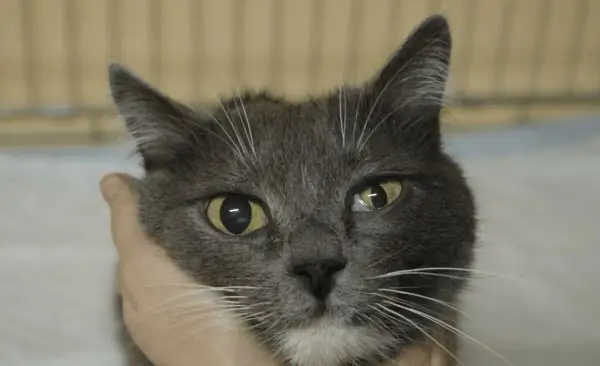
Ptosis - a disease in which the upper eyelid drops
Its reasons are very similar to those that cause the twist of the century:
- paralysis of the facial nerve;
- weakness of the circular muscle of the eye;
- complications of inflammatory diseases.
Accordingly, surgical treatment is the same as the treatment of volvulus.
Lagophthalmos
In appearance, an eye affected by lagophthalmos may resemble the eye of a cat suffering from ptosis. The eye slit is narrowed, but at the same time the animal cannot completely close the eyes, and also suffers from lacrimation.
The causes of lagophthalmos can be:
- paralysis of the facial nerve;
- scars that remain after volvulus or blepharitis;
- congenital pathologies.
Treatment of lagophthalmos is extremely rapid.
Other diseases
Less common eyelid conditions include:
- ankyloblefaron - fusion of the eyelids, or non-opening of the eyes in kittens, can be triggered by early conjunctivitis;
- simblefaron - fusion of the eyelids with the conjunctiva of the eye;
-
prolapse of the third eyelid - prolapse of the lacrimal gland.

Lacrimal gland prolapse of the third century Prolapse is a disease in which the lacrimal gland of the third eyelid loses its normal anatomical position, falls out of the conjunctival sac and becomes noticeable as a pink rounded formation in the inner corner of the palpebral fissure
For these diseases, only surgical treatment is indicated.
Diseases and injuries of the eyeball itself
Lesions of the eye itself are more dangerous than diseases of the eyelids, since they often lead to blindness. They can also be divided into inflammatory (conjunctivitis) and non-inflammatory (glaucoma).
Conjunctivitis
Conjunctivitis is one of the most common eye diseases in cats. This is partly due to the fact that it can be caused by many reasons, including:
- viruses, bacteria and fungi, and if the fungi affect the conjunctiva, then the viral infection can be generalized;
- allergens - cause inflammation of the conjunctiva, as well as symptoms such as itching, runny nose, watery eyes and sneezing;
- mechanical damage - serves as an entrance gate for infection;
- parasites, or rather, toxins released by them into the internal environment of the body;
- colds and weakened immunity;
- ultraviolet radiation (UV lamps, LED lamps for gel polish polymerization).
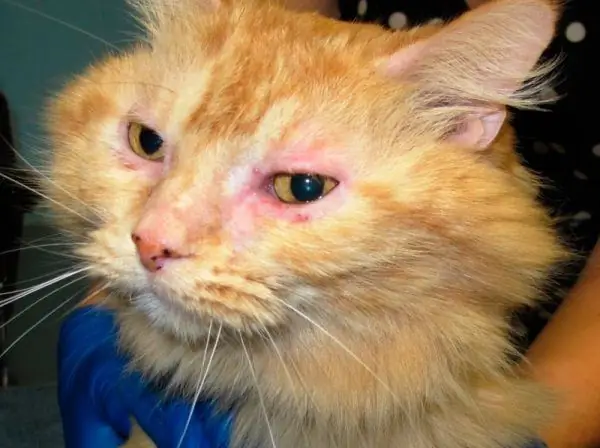
With conjunctivitis, cats' eyes become cloudy and their eyelids become swollen.
There are several types of conjunctivitis, which, if untreated, can turn into one another, and the course of the disease is complicated:
- catarrhal conjunctivitis is characterized by mucous discharge, edema and lacrimation, it is easy to get rid of it if you start treatment immediately;
- purulent is easily recognized by yellow-green secretions that accumulate in the corner of the eye and on the fur under it, the eyelids can stick together, it is dangerous with complications such as keratitis and panophthalmitis, which can lead to blindness;
- phlegmonous - with this type of conjunctivitis, pus not only comes out, but also accumulates intradermally, so getting rid of it is much more difficult;
- follicular - inflammation and protrusion of the follicles, which are located on the inner side of the eyelid, is a chronic disease that requires long-term and intensive treatment.
Treatment for conjunctivitis is determined by a veterinarian depending on the cause and type of the disease, but it usually goes through several stages:
- The veterinarian washes the eye with a furacilin solution. After that, at home, you need to wash the cat's eyes every 3-4 hours with black tea or a decoction of chamomile or calendula.
- After washing for the eyelid or in extreme cases, an antibacterial ointment is applied to the eyelid.
- Also, after each washing, drops prescribed by a doctor are instilled.
- If purulent, phlegmonous or follicular conjunctivitis is diagnosed, it is necessary to inject antibiotics intramuscularly; in case of an allergic variant, the animal is given antihistamines.
- After treating the cat's eyes, you need to wash your hands, since animal conjunctivitis is contagious to humans.
Keratitis
Keratitis is an inflammatory condition in which the cornea of the eye becomes cloudy. There can be many reasons for this:
- mechanical damage to the cornea due to impact or ingress of foreign bodies;
- corneal burns;
- infectious diseases affecting the body as a whole;
- inflammation of the lacrimal glands;
- avitaminosis;
- herpes virus;
- diabetes;
- chronic renal failure;
- conjunctivitis (keratitis can develop on its basis).
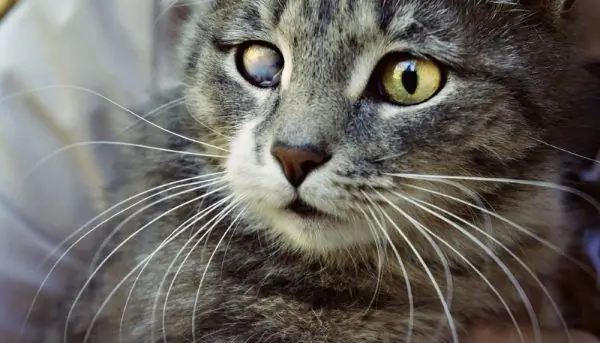
Keratitis is easily recognized by the cloudy cornea
Keratitis symptoms appear very quickly, and it is almost impossible not to notice them:
- the cornea of the eye loses its transparency, it can grow blood vessels;
- fluid accumulates under the cornea, it swells;
- discharge of mucus and pus from the eye appears;
- the cat suffers from photophobia.
First of all, the veterinarian must identify the cause of keratitis and, depending on it, prescribe treatment:
- if keratitis is caused by a fungus, long-term fungicidal ointments are indicated;
- with viral keratitis, drugs containing interferon are used;
- in case of bacterial infection, antibiotics and sulfa drugs are prescribed;
- with allergic keratitis, antihistamines help;
- bullous keratitis, characterized by the appearance of bubbles with fluid, is treated with Solcoseryl ointment.
Glaucoma
Glaucoma in cats, like in humans, is characterized by increased intraocular pressure and subsequent degenerative changes in the retina and optic nerve. The development of this pathology is caused by:
- arterial hypertension;
- age-related changes;
- untreated chronic diseases;
- congenital developmental pathologies;
- diabetes;
- genetic predisposition;
- long-term use of hormonal drugs.
The symptoms of glaucoma are:
- redness of the eyes;
- lacrimation;
- enlargement of the eye in size;
- permanent dilation of the pupil with a lack of response to light.
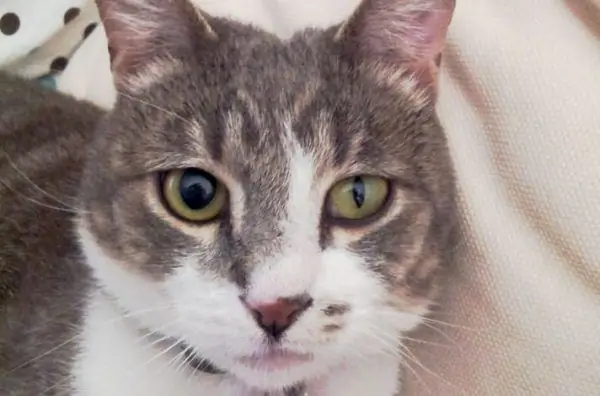
In glaucoma, the pupil in the affected eye is dilated and does not respond to light
Other eye diseases
Less common medical conditions sometimes encountered by cat owners include:
- exophthalmos - loss of the eye from the orbit due to the open structure of the orbit in cats, can be triggered by an infection or neoplasm;
- enophthalmos - drawing the eye into the orbit, it can also be caused by a tumor or inflammation;
- microfalm - a pathological decrease in the eyeball, often congenital, can appear in kittens whose mother was treated with teratogenic drugs during pregnancy;
- proptosis - complete prolapse of the eyeball, to which Persian cats are predisposed, in some cases it is possible to correct the eye, in others it is necessary to resort to removal;
- uveitis - damage to the choroid, in which the iris is involved in the process, is treated with great difficulty;
- iritis - inflammation of the iris and ciliary body, which can be stopped with ointments and antibiotic drops;
- dermoid is a very rare disease in which the eye grows with skin tissue with hair follicles, surgical removal of the altered areas is indicated;
- atrophy - compression of the eyeball, in which its removal is indicated.
What symptoms do you need urgent veterinarian help?
A healthy cat should have clean, shiny, wide-open eyes, and the animal should not rub them frequently with its paw. Any of the following symptoms are a reason to see your doctor immediately:
- redness, swelling, or thickening of the eyelids;
- discharge from the corners of the eyes of mucous, purulent or bloody contents;
- lacrimation;
- photophobia;
- lack of reaction of the pupils to light;
- itching, forcing the cat to rub its eye with a paw or rub its muzzle against objects;
- inability to completely open or close the eyelid, frequent blinking of one eye;
- foreign bodies in the eye, neoplasms on the eyelids;
- blurred or reddened eyes;
- creeping into the eye of the third century;
- wounds, burns or bruises of the eyes and eyelids;
- soreness to touch.
Medicines used for eye conditions in cats
The main forms of release of drugs prescribed in the treatment of eye diseases are ointments and drops. They also differ in their area of action - some are active against bacteria, others against viruses and fungi.
Table: drugs used for different types of eye lesions
| Indication | Drugs | Operating principle | Application | The cost |
| Inflammatory diseases | Tsiprolet | Ciprofloxacin has a bactericidal effect on streptococci, chlamydia | For the prevention of complications after surgery | 50-80 RUB |
| Diamond eyes | Contains chlorhexidine and taurine, anti-inflammatory effect | Retinal degenerative changes, cataract prevention | 150-210 RUB | |
| Bacterial infections | Leopard |
Levomycetin and furacilin have a bactericidal effect on a wide range of microorganisms |
|
130-170 RUB |
| Iris |
Gentamicin sulfate eliminates infectious agents |
|
160-200 RUB | |
| Levomycetin |
Active against penicillin- resistant microorganisms |
|
10-30 RUB | |
| Viral infections | Anandin |
Glucaminopropylcarbacridone is effective against chronic and acute viral infections |
|
45-190 RUB |
| Mechanical damage | Traumeel | Has anti-inflammatory effect, relieves pain |
|
400-500 RUB |
| Fungal lesions | Tetracycline ointment |
Antibiotic with a broad spectrum of action, active against bacteria, fungi, protozoa |
|
50-250 RUB |
Most often, the drugs are not used individually, drops are usually combined with ointment and eye rinsing. Some products are multifunctional, for example, Iris drops can be used for almost any disease. The combination of medicines is selected by the veterinarian in each case individually.
Photo gallery: medicines for eye diseases
-

Tsiprolet - Tsiprolet - ophthalmic drops indicated for a number of diseases and visual defects
-

Bars eye drops for cats - Bars eye drops are a combined antimicrobial drug intended for animal eye care
-

Tetracycline eye ointment - Tetracycline ointment - a broad-spectrum antibiotic
-

Anandin eye drops - Anandin - eye drops for veterinary purposes, used for the treatment of rhinitis and conjunctivitis in animals, immunomodulator
Folk remedies for treating eyes in cats
In cases where going to the doctor and buying medicines is not possible, you can resort to home remedies. Usually use:
- tea - a tablespoon of black tea is brewed with a glass of boiling water, allowed to cool, a cotton pad is moistened in the tea leaves and rubbed with a sore eye;
- elderberry infusion - 10 grams of dried elderberry pour 100 ml of boiling water, let it brew for 45 minutes, then strain;
- infusion of celandine - grind 5 leaves of the plant and pour two tablespoons of boiling water, let it brew for half an hour and strain;
- infusions of calendula, chamomile or St. John's wort - pour 2 tablespoons of dried leaves with a glass of boiling water, leave for 15 minutes and then strain;
- aloe leaf juice - grind 2-3 pieces in a blender and strain the juice through cheesecloth.
All funds are used according to the same scheme:
- A cotton pad is moistened in a liquid and gently run over the eye from the outer corner to the inner corner.
- After each pass, the disc is replaced with a new one.
-
Both eyes must be treated, even if one of them looks healthy.

The cat is rubbing his eyes with a cotton pad The cat's eyes must be wiped from the outer corner to the inner corner to avoid the spread of infection to healthy areas
Folk remedies are suitable only as a temporary measure to alleviate the condition of the animal; for a full recovery, the treatment prescribed by the doctor is still necessary.
Video: the veterinarian shows how to properly handle the eyes of cats
Rules for conducting medical procedures at home
In order for eye treatments to work as effectively as possible, you need to follow the rules:
- If the discharge has dried and glued the cat's eyelids, you need to gently soak the crusts. To do this, it is enough to apply a cotton pad soaked in warm boiled water to your eyes several times, after which you can gently push your eyelids apart with your fingers.
- Then it is necessary to rinse the eye, pouring it with an infusion of herbs or a pharmaceutical agent from a syringe or applying a generously moistened cotton pad.
- After rinsing, you need to drip drops, fixing the cat's head and pushing the lower eyelid, or apply an ointment.
-
If the cat rubs its eyes with its paws, put on a protective collar.

Cat in an Elizabethan collar To prevent the cat from touching its eyes with its paws, a special protective collar is put on it
- Wash your hands thoroughly after the procedure.
Caring for cats with eye conditions
A sick cat needs special care to relieve its condition:
- it is better to cut off the tips of the claws with special tweezers so that the animal does not accidentally touch the eye;
- dehydration worsens the condition of the body, therefore, if the cat refuses water, it is worth giving it to drink from a pipette or wetting the lips;
- wool, especially long hair, needs to be combed more often than usual, since it can fall off from prolonged lying, you should not bathe your pet during this period;
- if the cat is prescribed antibiotics, stomach upset may occur, so it is worth starting a course of prebiotic;
- eliminate irritating factors in the room where the animal is located - dust, bright light, other animals;
- during the course of treatment, the cat must not be allowed out into the street.
Features of the treatment of eye diseases in pregnant cats and kittens
Infectious diseases in pregnant cats are dangerous due to the likelihood of abortion or the birth of dead kittens. If signs of eye disease appear, you should immediately consult a doctor and get tested to identify the pathogen.
Veterinarian prescribes intramuscular antibiotics intramuscularly to cats during pregnancy with great caution, since many of them have teratogenic activity, and does this only if the risk to the cat's health outweighs the risk of having sick kittens. Most often, pregnant cats are buried Iris in the eyes, sometimes tetracycline ointment is placed behind the eyelid.
Treatment of kittens differs from the therapy prescribed for adult cats, only with a reduced dose of the drug. After recovery, it is necessary to give the kitten anthelmintic and make age-appropriate vaccinations.
Diseases not related to the eyes
Some of the symptoms common to feline eye conditions can sometimes be a sign of other dangerous conditions:
- photophobia, the desire to hide in a dark place sometimes appears in pregnant cats, as well as in animals that are under stress, for example, due to moving or the appearance of other animals in the house;
- photophobia can also be a symptom of rabies, although usually in this case it is combined with aggressive behavior, seizures, foam from the mouth;
- viral diseases such as panleukopenia or calcivirosis can cause cats to avoid bright lights
- heatstroke can cause reddening of the whites of the eyes in cats;
- if your cat has red eyes, remember if you have bathed her recently, maybe soap or other irritating substances got into your eyes;
- mycoplasmosis and chlamydia can also cause eye redness;
- lacrimation can be the cause of helminthic invasion;
- with a cold, there may also be profuse discharge from the corners of the eye;
- Older cats have watery eyes in windy weather.
Prevention of eye diseases in cats
In most cases, preventing eye diseases is much easier than treating them. To do this, it is enough to follow a few rules:
- vaccinate against viral diseases of cats annually;
- if the cat is being walked, after each walk it is necessary to examine the eyes for the presence of foreign bodies and lacrimation;
- cats, especially long-haired cats, need to be combed regularly, as hair can also get into the eye;
- once every 3-4 months, carry out deworming and periodically give your pet vitamins;
- avoid contact with stray animals;
- regularly treat the eyes of the animal with a special lotion.
Veterinarian recommendations
Not only street cats, but also domestic cats often suffer from eye diseases. For the owner faced with such a problem, the most important thing is to immediately take the pet to the veterinarian and then strictly follow the prescribed therapy, because almost all diseases detected at an early stage end in full recovery.
Recommended:
Ear Mite (otodectosis) In Cats And Cats: Photos, Symptoms Of The Disease And Its Treatment At Home (including A Kitten), Reviews
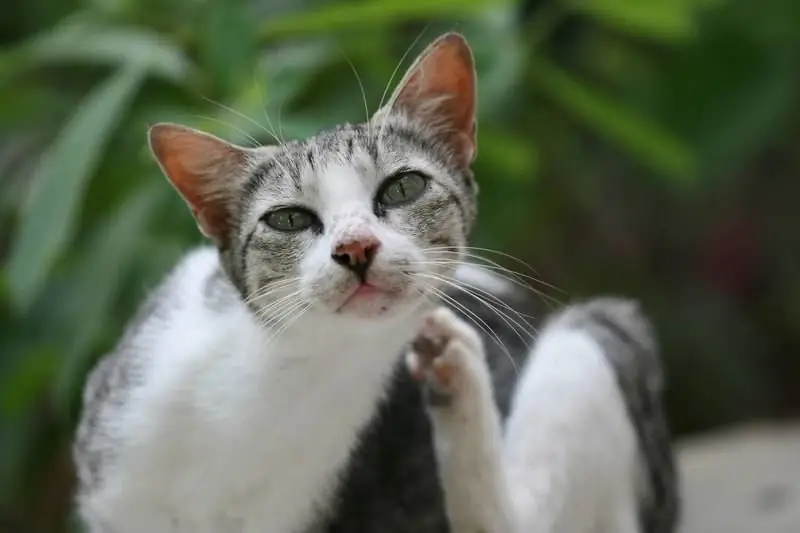
Description of the causative agent of otodectosis, how the infection occurs, the symptoms of the disease. How to diagnose and treat otodectosis. Preventive measures
Renal Failure In Cats And Cats: Symptoms, Treatment, How To Save A Kitten And An Adult Animal (recommendations Of Veterinarians)
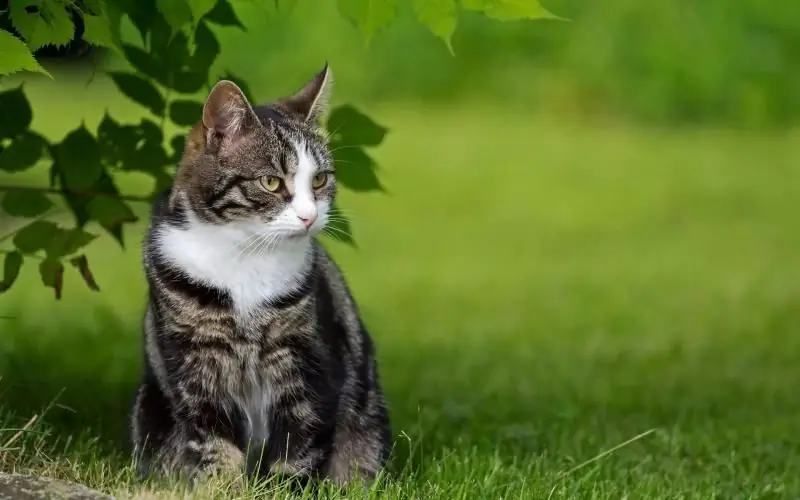
Types of renal failure in cats The reasons for its development. How pathology manifests itself and is diagnosed. Inpatient and home treatment. Prevention
Eosinophilic Granuloma In Cats: Symptoms And Treatment At Home, Prevention And Recommendations Of Veterinarians
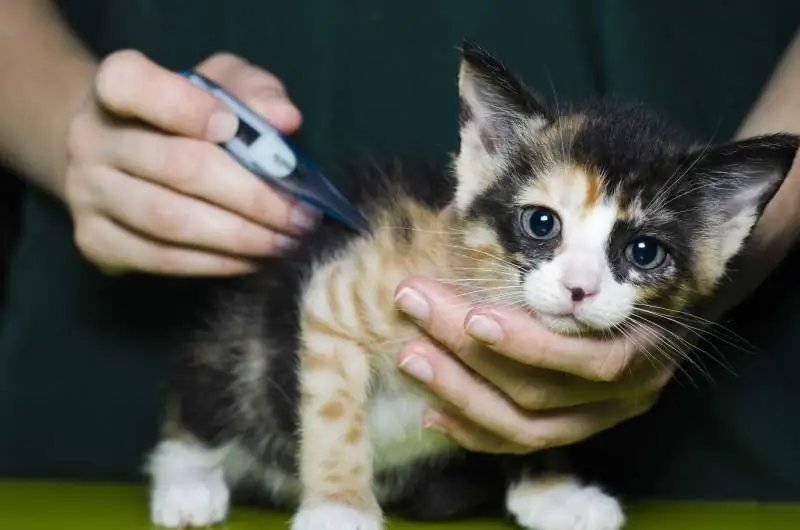
How does eosinophilic granuloma of cats look and proceed? Causes, diagnosis, prevention and treatment methods. Veterinarian recommendations
Enteritis In Cats: Symptoms, Diagnosis And Treatment (including At Home), Prevention, Recommendations Of Veterinarians
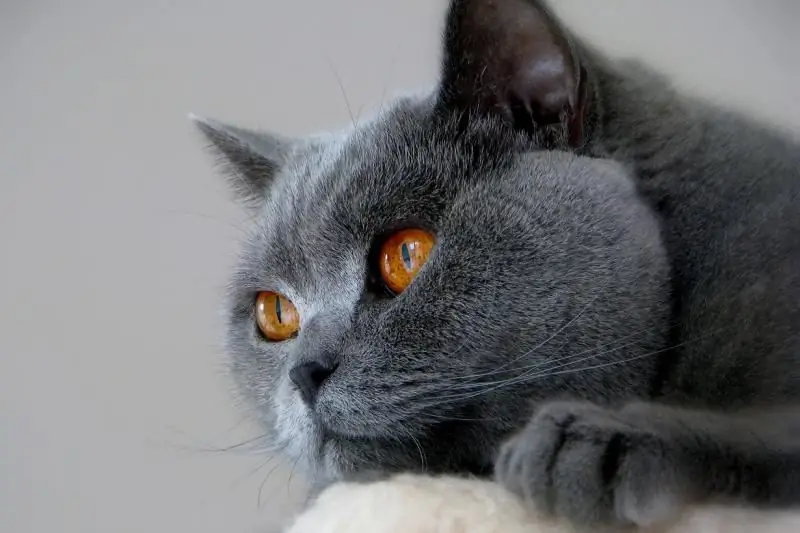
What is viral enteritis. Infection routes. Types of the disease. When to see your veterinarian. How to treat at home. Prevention. Doctor's advice
Red Gums In Cats (including Gingivitis): Symptoms, Photos Of Redness Around The Teeth, Diagnosis And Treatment At Home
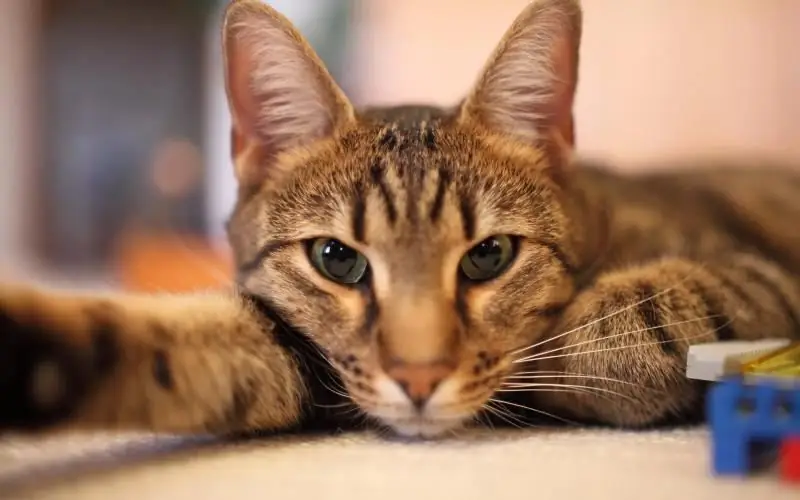
What do red gums look like in a cat? What conditions may be a symptom of redness. Types of gingivitis and their causes. How to treat pathology. Prevention
